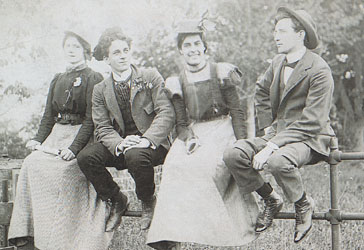 |
 |
| current issue |  |
past issues |  |
send a letter/news |  |
address update |  |
advertise |  |
about us |  |
alumni home |
On Ben's Farm
The Way We Wereby Mylinda Woodward '97
 Members of the Class of 1900 show off the latest Durham fashions.
Members of the Class of 1900 show off the latest Durham fashions.
|
A century ago, the New Hampshire College of Agriculture and the Mechanic Arts was just beginning to put down roots in what had been a quiet farming community. Only seven years before, the college had moved from Dartmouth College to the new campus bequeathed to the state by Benjamin Thompson. Already the little college with the big name was changing Durham in dramatic ways.
By 1900, six buildings stood where Thompson's cattle had grazed: Thompson Hall, a science building (Conant Hall), the Agricultural Experiment Station (Nesmith Hall), a shop building (Hewitt Hall), a greenhouse and a barn. A seventh building, a gigantic three-story barn designed by George Whitcher, director of the Agricultural Experiment Station, was built in 1893 but burned a year later.
Other modern improvements quickly followed. Dean Charles Pettee supervised the resurfacing of Main Street with macadam to handle the increased traffic. Members of the faculty installed phones to connect their homes with their offices. The college built a reservoir and laid pipes to serve the surrounding area.
The original state appropriation did not include funds for dormitories. No one expected this to become a problem as quickly as it did. The first freshman class in Durham was 51 students—quite a jump from five the year before—and there weren't enough houses in town to provide rooms for all of them.
| Then and Now | ||
| 1900 | 2000 | |
| Students | 113 | 12,500 |
| Tenure-track faculty | 19 | 646 |
| Women students | 13 | 7,427 |
| Courses | 98 | 2,000 |
| Academic buildings | 6 | 80 |
| Dorms | 0 | 26 |
| Library books | 9,000 | 1.1 million |
| Colleges | 1 | 7 |
| Majors | 10 | 100 |
| Out-of-state students | 19 | 4,078 |
| Athletic teams | 3 | 22 |
| Most popular major | engineering | business administration |
| Tuition | $60 | $5,140 in-state $13,860 out-of-state |
Commuting at the turn of the century was difficult. Long distances were traveled by horse and buggy, train or sleigh. The trek to Dover was often accomplished by bicycle or on foot. One of the first automobiles in Durham was owned by Professor Frederick 'Pa" Taylor, who acquired it around 1902. Several years later, a special course on the automobile proved very popular.
Military drill was compulsory for male students, who had cadet corps uniforms made to measure from cloth bought at Sawyer's mills. The smart gray uniforms fit better than most students' ordinary clothing, so some of the men wore them almost all the time. Women's attire consisted of voluminous floor-length skirts and high-necked, long-sleeved blouses, and no coed would think of going outdoors without a hat.
Popular pastimes for students included dances, whist and nutting parties. Most gatherings involved music, and a few students owned phonographs. In winter they played ice polo (now hockey), skated on the reservoir or rented a horse and sleigh.
Finding enough women for a dance was always a problem. Daughters of faculty members and townspeople were frequently invited, and girls from out of town were welcomed even by women students. Custom dictated that a girl could not dance more than once with anyone until she had danced with all the unpartnered men.
The 20th century was greeted with enthusiasm and optimism. The nation was at peace, the economy was thriving and science and technology were introducing new marvels almost faster than people could adjust to them. The future looked bright. Melvin White, Class of 1903, could have been speaking for all his fellow students when he observed, 'Every loyal New Hampshire man should . . . look forward to the time when our college will take rank with the first colleges of the land."
Mylinda Woodward '97 is the university's assistant archivist.
blog comments powered by Disqus

